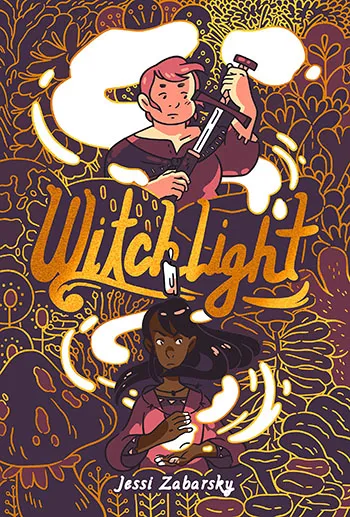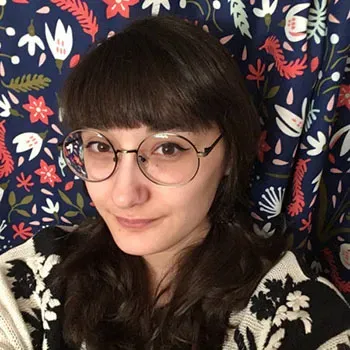Good art can unlock emotions words fail to describe. At least, that's how graphic novelist and author Jessi Zabarsky feels. For eight years, she worked to combine her writing talent with her passion for art to create the delightful and whimsical graphic novel Witchlight. Following the adventures of a witch and a peasant girl, it pulls inspiration from many of her childhood favorites, while also putting a new spin on the classic literary form.
Turning artwork into a novel
At first, the novel started as an experiment for Zabarsky to work on her art. "Whenever I work on any kind of comic project, I like to give myself specific challenges. Mostly because I'm bad at keeping a sketchbook or practice drawings, so I have to do it all in my actual work," she said.
"So, I realized I hadn't been drawing a lot of human figures, and I wanted to get that down. I had been drawing a lot of animals, so I wanted to do something with actual human characters. I... had done an art test for a job that I applied to, and the main character of Witchlight was actually conceptualized in that art test, and she stuck with me."
Zabarsky did not set out to create a novel, but rather just to get to know her character better and sketch the beauty she found around her home. "I thought she was so cool-looking, and I wanted to know more about her. I kept drawing her, and I started populating the world more. I was living in a forested, rural area, and I was going for walks a lot and wanted to capture this... tree-filled environment."
Eventually, she decided to write a short story for her character. "So... this [graphic novel] was unplanned. I initially made just the first chapter, then I was planning on it being that long, 18 pages, because I had gotten into a big comic show that I like, called Decaf, for the first time, and I wanted to have something new and special. Then I realized that the story was a lot bigger and it wouldn't fit in 18 pages, so I kept adding chapters, and before I knew it, it was 200 pages long," she said, laughing.
Once she had completed the novel, she caught the attention of a small publisher. "I definitely kind of tricked myself into making it, and then it was collected in black-and-white by Chatbooks, and they published it and distributed it, and we had a Kickstarter," she aid.
The little black-and-white novel continued to catch the eyes of readers and publishers, and before she knew it, Zabarsky had a second publishing deal in the works. "Through [both me and the publisher] taking it around to a bunch of different shows..., one of the representatives from [Random House Graphic] came across it and liked it and wanted to publish it."

Even though the process of publishing Witchlight was unanticipated, she admits it wasn't easy or quick. "Making the initial black-and-white version was probably three or four years, and then it was circulating in that form for a while, and then in 2018, I believe, is when Random House reached out to me and sent me an offer. Then there was a process of finding a colorist, and they did their work. Then ironing out a new cover, and all of that. It was finally printed and published in 2020, so it took eight years."
Queer fantasy
Zabarsky grew up an avid reader. "It's something I loved all the time. My mom was a big reading proponent, so I grew up with many of these library books around."
She especially connected with the fantasy genre. "It felt like the real world could have secrets in it, so reading and writing fantasy felt natural, like I'll uncover it."
But she always felt there was a piece of her missing from the characters and stories she loved so much. As Witchlight started to gain traction, she realized she had an opportunity to share a unique story with the world, one that explored queerness in a way she hadn't yet seen.
"At that time, the explosion of Queer comics was kind of just starting. There was a little bit out there, but I wasn't connected to a lot of it. I wanted to see the kinds of magical fantasy stories that I grew up loving, but with Queer characters in them," she explained.
Queerness, like fantasy, often follows the idea of discovering secrets society wants to keep hidden, and embracing the magic that for some is misunderstood. Through her fantasy work, Zabarsky hoped to connect with Queer readers who may also feel isolated or disconnected from mainstream fantasy books.
"For me, it's very much about self-acceptance and learning vulnerability and being able to share yourself and lean on other people," she said. "As far as queerness, [in] pretty much all my Queer work, I wanted to feel natural and easily part of the world. It's never something the characters question. It just exists, and it's almost a background element."
Illustrating new worlds
While writing comes naturally to Zabarsky, she is always working to improve her drawing skills. "Illustrating, drawing, is more difficult and takes way more time. Writing for me is a lot of fun. I grew up reading a lot and telling stories and doing imagination play for fun. I've grown up treating writing as not a big deal. It's not intimidating for me. So [for] each of the Witchlight chapters..., I would keep a file of notes and ideas, and when it came time to write the chapter, each of them was done in a day."
Even though the illustrations take more work, she believes it's the art that makes graphic novels so special. "I think there's a lot of advantages to graphic novels. Just in how you can tell a story or portray an emotion or setting, with all the specificities of a place. You kind of have to be a little vaguer in an all-prose novel, because you don't have a billion words."
She enjoys using her images to tell the story and reserves words more for dialogue. "I tend to write graphic novels that are sparse words-wise. I tend to convey things in images more, and I enjoy getting into the subtleties of a person's changing emotion on their face or their body language or how they're moving and really feeling the impressiveness or the beauty of the place that they're in. I think that's pretty particular to comics."
While the content of her stories pulls from the fantasy novels she grew up reading, she says her art is influenced by work from other cultures. "It's influenced by anime and manga, but kind of blended with an American web-comic style, I'd say. Both of those genres were very influential for me as a teen, so it's got a simplicity and a clean line kind of aspect to it, but also I draw a lot of softly rounded forms. One of the formative mangas for me was Ranma ½. I love her round, soft little martial arts characters, kicking and punching, and looking so cute doing it."
Next projects
Fans won't have to wait eight more years to see what Zabarsky has coming up next. "So, my second graphic novel came out earlier this year: Coming Back. It's got similar vibes to Witchlight, a lot of softness and feelings and going on adventures and figuring yourself out. It's a little stranger than Witchlight – definitely starting to explore just being the weird fantasy that I like."
Coming Back involves a new world, unlike the one she created for Witchlight. "There are a lot more nonhuman creatures and characters in Coming Back. There's magic, obviously, but the magic... is body transformative in a lot of instances. Almost edging into body horror sometimes. It's not too much of a spoiler, but the main community in Coming Back is all women, and they reproduce basically by growing plants, and the plant grows the baby... Stuff like that, where it's very specific to my world I created."
Her next few projects are still top secret, but aside from publishing, Zabarsky releases weekly sketches on her social media platforms for fans to enjoy. "The thing that is most accessible is that I do little four-panel journal comics every week, where I draw myself as a little rabbit, and those are posted on my Instagram and my Twitter every Tuesday night if you need a quick fix," she said with a laugh.
Although Zabarsky is still pretty tight-lipped on what her next published project will look like, she can assure readers that it will be Queer. "Even though there's been so many more wonderful Queer stories and Queer comics, I'm still wanting to get into to specific kind that I like and that I want to see out there. It's just a really interesting thing for me to explore."


